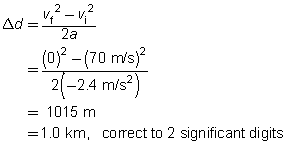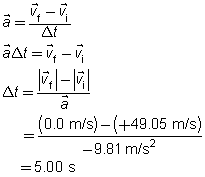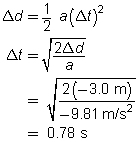Module 1—Motion
 Module 1: Lesson 5 Assignment
Module 1: Lesson 5 Assignment
Remember to submit the answers to LAB 1, LAB 2, LAB 3, LAB 4, and LAB 5 to your teacher as part of your Module 1: Lesson 5 Assignment.
 Lesson 5 Lab: Could You Be a Goalie for the NHL?
Lesson 5 Lab: Could You Be a Goalie for the NHL?
Complete “1-8 QuickLab: Could You Be a Goalie for the NHL?” on page 57 of your textbook. In step two of the procedure, have the zero end of the ruler just above your hand. In step 6, record where the top of your hand is on the ruler.
LAB 1. Complete steps 1–7 of “Procedure” on page 57 of your textbook. For step 6, you should complete at least three trials. List your trial results.
LAB 2. Answer question 1 on page 57 of your textbook.
LAB 3. Answer question 2 on page 57 of your textbook.
LAB 4. Answer question 3 on page 57 of your textbook.
LAB 5. Answer question 4 on page 57 of your textbook.
Example Problem 5: The driver of a car travelling east at 30.0 m/s applies the brakes to generate an acceleration of 4.00 m/s2 west. If the final speed of the car was 5.00 m/s east, how far did the car travel in the acceleration period?
Given |
 |
|---|---|
Required |
the distance travelled (Δd) |
Analysis and Solution |
Choose east as the positive direction. The equation that contains all the variables is
|
Paraphrase |
The distance travelled was 109 m. |

© Greg Niemi /BigStockPhoto
An airliner lands on a runway during sunset.
 Self-Check
Self-Check
SC 4. Solve a problem like the investigators of the Air France crash had to grapple with by answering practice problem 1 of “Example 1.16” on page 52 of your textbook.
 Self-Check Answer
Self-Check Answer
SC 4.
Given

Required
(a) the acceleration of the jet (![]() )
)
(b) the minimum length of runway (Δd)
Analysis and Solution
(a) The equation that contains all the variables for part (a) is ![]()

(b) The equation that contains all the variables for part (b) is ![]() ; however, it will have to be manipulated to isolate Δd.
; however, it will have to be manipulated to isolate Δd.

Paraphrase
The acceleration of the jet is –2.4 m/s2 [forward], and the minimum length of the runway is 1.0 km.
 Module 1: Lesson 5 Assignment
Module 1: Lesson 5 Assignment
Remember to submit the answer to TR 3 to your teacher as part of your Module 1: Lesson 5 Assignment.
 Try This
Try This
TR 3. A rocket sled that was initially at rest reaches a final speed of +30.0 m/s over a displacement of +45.0 m.
- Find the acceleration.
- Find the time it took to travel the first 45.0 m.
 Read
Read
What happens when the acceleration is caused by gravity? Read from the top of page 56 through the end of “Example 1.17” on the top of page 58.
Example Problem 6: How fast will a falling object travel after 7.00 s if it is dropped from rest?
Given |
 |
|---|---|
Required |
the final velocity ( |
Analysis and Solution |
Choose the positive direction to be upwards. The equation, that will have to be manipulated to get
= 0.0 + (–9.81 m/s2)(7.00 s) = –68.7 m/s |
Paraphrase |
The final velocity of the object will be 68.7 m/s downward. |
Example Problem 7: A man standing on the roof of a building throws a stone downward at 20.0 m/s. The stone hits the ground after 5.00 s. How tall is the building?
Given |
 |
|---|---|
Required |
the height of the building |
Analysis and Solution |
Choose the positive direction to be upwards. The distance the stone falls is equal to the height of the building. The equation that contains the variables is
= –100 m + (–123 m) = –223 m |
Paraphrase |
The height of the building is 223 m. |
 Read
Read
Read pages 59 to 61 of your textbook to see examples of problem solving with projectiles directed upwards. Pay careful attention to the analysis for part (a) in both “Example 1.18” and “Example 1.19,” and note the equations chosen in both examples in parts (a) and (b).
 Self-Check
Self-Check
SC 5. When an object is thrown upwards, what is its final velocity at the maximum height?
SC 6. When an object that is thrown upwards begins to fall back down, what is its initial velocity for the downward path?
 Self-Check Answers
Self-Check Answers
SC 5. The velocity at the maximum height is 0.00 m/s.
SC 6. The initial velocity for the downward path is 0.00 m/s.
Example Problem 8: An object is thrown upward at 49.05 m/s.
- What is the object’s velocity at 3.00 s?
Given

Required
the velocity after 3.00 s
(
 )
)Analysis and Solution
Choose the positive direction to be upward. The equation, which will have to be manipulated to get
 , is
, is
= (+49.05 m/s) + (–9.81 m/s2) (3.00 s)
= +19.6 m/s
Paraphrase
The velocity at 3.00 s is 19.6 m/s [upward].
- What is the velocity after 7.00 s?
Given

Required
the velocity after 7.00 s (
 )
)Analysis and Solution
Choose the positive direction to be upward. The equation, which will have to be manipulated to get
 , is
, is
= (+49.05 m/s) + (─9.81 m/s2)(7.00 s)
= ─19.6 m/sParaphrase
The velocity at 7.00 s is 19.6 m/s [downward].
The velocity after 7.00 s is –19.6 m/s.
- The object momentarily stops moving vertically at the maximum height. How long does it take to reach its maximum height?
Given

Required
the time to reach its maximum height (Δt)
Analysis and Solution
Choose the positive direction to be upward. The equation, which will have to be manipulated to get Δt, is
 . Remember, you cannot divide vectors. You can only divide the magnitudes of the vectors.
. Remember, you cannot divide vectors. You can only divide the magnitudes of the vectors.
Paraphrase
The time to reach its maximum height is 5.00 s.
- What is the maximum displacement?
Given

Required
the maximum displacement (
 )
)Analysis and Solution
Choose the positive direction to be upward. The equation to use is

= (+49.05 m/s)(5.00 s) + ½(─9.81 m/s2)(5.00 s)2
= +245.3 m + (─122.6 m)= +123 m
Paraphrase
The maximum displacement of the object is 123 m [upward].
 Self-Check
Self-Check
SC 7. Go to page 63 of your textbook and answer question 10 of “1.6 Check and Reflect.” (Hint: Problems like this are most easily solved by taking the downward half of the projectile’s path.)
 Self-Check Answer
Self-Check Answer
SC 7.
Given
For the last half of the kangaroo’s jump:

Required
the time the red kangaroo is in the air (2Δt)
Analysis and Solution
Use the equation ![]() . The initial velocity of the downward path is zero, so the
. The initial velocity of the downward path is zero, so the ![]() Δt part of the equation equals zero and the equation becomes
Δt part of the equation equals zero and the equation becomes ![]() . (That is why it is best to choose the downward path: It eliminates the initial velocity. Otherwise, there are two unknowns and the solution is considerably more difficult.) Manipulate this equation to isolate Δt, using the scalar form of the equation because you cannot divide by a vector.
. (That is why it is best to choose the downward path: It eliminates the initial velocity. Otherwise, there are two unknowns and the solution is considerably more difficult.) Manipulate this equation to isolate Δt, using the scalar form of the equation because you cannot divide by a vector.

The time for the up and down path will be 2 × (0.78 s) or 1.6 s.
Paraphrase
The red kangaroo will remain in the air 1.6 s.
 Module 1: Lesson 5 Assignment
Module 1: Lesson 5 Assignment
Remember to submit the answer to TR 4 to your teacher as part of your Module 1: Lesson 5 Assignment.
 Try This
Try This
TR 4. A water balloon is dropped on some unsuspecting sunbathers from a stationary hot air balloon. The water balloon is 353 m above the beach. If the water balloon accelerates downwards at 9.81 m/s2, how long will it take to hit the beach?
 Read
Read
How do these formulas tie into the graphs that you studied in the first four lessons? Read from the middle of page 61 to the bottom of page 62 of your textbook.
 Self-Check
Self-Check
SC 8. Go to page 62 of your textbook and answer questions (a) and (b) of “Concept Check.”
 Self-Check Answers
Self-Check Answers
SC 8.
(a) The defining kinematics equation for a ball thrown straight up is ![]() .
.
(b) The expected value of the slope of the velocity-time graph in “Figure 1.67(b)” is –9.81 m/s2.


